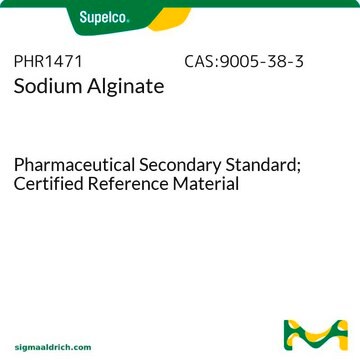A0682
Ácido algínico
BioReagent, suitable for plant cell culture, low viscosity, powder
Sinônimo(s):
Algina, Alginato de sódio
About This Item
Produtos recomendados
fonte biológica
algae (brown)
linha de produto
BioReagent
forma
powder
técnica(s)
cell culture | plant: suitable
viscosidade
4-12 cP, 1 % in H2O(25 °C)(lit.)
aplicação(ões)
agriculture
InChI
1S/C6H10O7.Na/c7-1-2(8)4(5(10)11)13-6(12)3(1)9;/h1-4,6-9,12H,(H,10,11);/q;+1/p-1/t1-,2-,3-,4?,6+;/m0./s1
chave InChI
MSXHSNHNTORCAW-MPGIDXPLSA-M
Procurando produtos similares? Visita Guia de comparação de produtos
Aplicação
Outras notas
Código de classe de armazenamento
11 - Combustible Solids
Classe de risco de água (WGK)
WGK 1
Ponto de fulgor (°F)
Not applicable
Ponto de fulgor (°C)
Not applicable
Equipamento de proteção individual
Eyeshields, Gloves, type N95 (US)
Certificados de análise (COA)
Busque Certificados de análise (COA) digitando o Número do Lote do produto. Os números de lote e remessa podem ser encontrados no rótulo de um produto após a palavra “Lot” ou “Batch”.
Já possui este produto?
Encontre a documentação dos produtos que você adquiriu recentemente na biblioteca de documentos.
Os clientes também visualizaram
Nossa equipe de cientistas tem experiência em todas as áreas de pesquisa, incluindo Life Sciences, ciência de materiais, síntese química, cromatografia, química analítica e muitas outras.
Entre em contato com a assistência técnica






